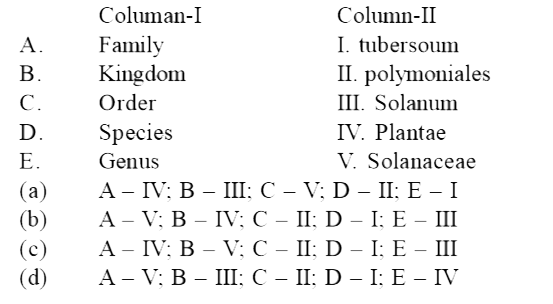Match column I with column II and choose the correct answer

(A) — (3), (B) — (5), (C) — (4), (D) — (2), (E) — (1)
(A) — (3), (B) — (5), (C) — (4), (D) — (1), (E) — (2)
(A) — (6), (B) — (3), (C) — (4), (D) — (2), (E) — (1)
(A) — (6), (B) — (4), (C) — (3), (D) — (2), (E) — (1)
The correct Answer is:A
(A) — (3), (B) — (5), (C) — (4), (D) — (2), (E) — (1)
Similar Questions
Knowledge Check
Match column I with column II and choose the correction answer
 A(A)−(3),(B)−(5),(C)−(4),(D)−(2),(E)−(1)B(A)−(3),(B)−(5),(C)−(4),(D)−(1),(E)−(2)C(A)−(6),(B)−(3),(C)−(4),(D)−(2),(E)−(1)D(A)−(6),(B)−(4),(C)−(3),(D)−(2),(E)−(1)
A(A)−(3),(B)−(5),(C)−(4),(D)−(2),(E)−(1)B(A)−(3),(B)−(5),(C)−(4),(D)−(1),(E)−(2)C(A)−(6),(B)−(3),(C)−(4),(D)−(2),(E)−(1)D(A)−(6),(B)−(4),(C)−(3),(D)−(2),(E)−(1)Match the column I with column II and choose the correct answer column I
a.crista ampullaris
b.Macula
c.Helicotrema
d.Fenesta rotundus column I I
1.Connection between scala vestibuli and scala tympani
2.Dynamic balance of body
4.Static balance of bodyAa3 b4 ci diiBa4 b3 c1 d2Ca4 b3 c2 d1Da3 b4 c2 d1Match column I and column II and choose the correct answer code :
Column IColumn II(Type of Drug)(Clinical Use)a.Tranquilisers(i)Hypnoticb.Opiate narcotics(ii)Narcrolepsyc.Stimulants(iii)Fantansyd.Hallucinogens(iv)AnalgesicAa(i), b(ii), c(iii), d(iv)Ba(i), b(iv), c(ii), d(iii)Ca(iii), b(i), c(iv), d(ii)Da(iv), b(iii), c(ii), d(i)
Match column I with column II and select the correct answer by the given codes

View SolutionMatch column I and column II and choose the correct answer code :
Column IColumn II(Psychological Disorders)(Symptoms)a.Mood disorders(i)Distorted thoughtb.Schizopherina(ii)Depressionc.Borderline personality disorder(iii)Sweating nausea diarrhoea trembling etc.d.Anxiety disorder(iv)Quarrelsome behaviour
View SolutionMatch column I with column II and choose the correct option.

View SolutionMatch column I with column II and choose the correct option.

View SolutionMatch the items in column I with column II and choose the correct answer.

View Solution


